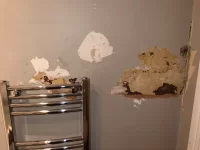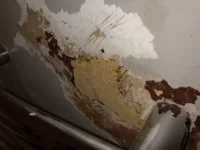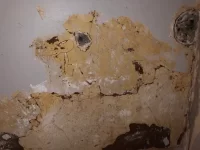I live in the basement flat of a Victorian house that was converted back in the early 80's. During my two years here I've noticed damp issues with quite a few of the walls, where paint and other unidentified layers have come away from the walls. I'm wondering if these problems are mostly due to the previous owners patching up and painting walls using using materials inappropriate for older properties that need to breath, i.e. hydroscopic plaster and non porous paints. I'm hoping that it'll not be too difficult or expensive to remedy the troublesome patches of wall. I'm not looking for perfect results because I can't afford it, just reasonably presentable and stable.
The Living Room
The photos of the white wall show the result of me lightly scraping at the wall to remove the paint that had bubbled from the wall. None of my walls are subterranean. The living room wall adjoins with my neighbour who has no damp problem. Not sure what exactly caused the damp. Above is a communal hallway with no pipes. Perhaps something was spilled in the past. Is rising damp a fallacy? The paint is glossy and perhaps non porous, so maybe the damp is just accumulation of a damp basement wall not able to breath? The paint is fairly well adhered where is hasn't peeled away. In a few places on the exposed plaster there are brown powdery raised specks.
The plaster to the right looks like new plaster, and the paint is only a couple of layers thick, whereas the top left darker plaster looks like older plaster and the paint that has come away is a lot thicker. Any thoughts on what to do would be gratefully received! Can I try just repainting the wall with a particular type of paint? Do I need to remove all the remaining paint somehow to get a smooth surface, or can I skim or sand it with something first?




The Bathroom
The blue wall with radiator is in my bathroom. Again the paint is shiny and perhaps not very porous. I've removed the loose paint with a scraper. You can see there are still bits of paint that are slightly darker/damp. Not sure exactly what all the layers of this wall are. It looks to be constructed of black breeze block stuff, as in the black circle to at the right of the image is a pretty deep gouge into the wall. The light yellow layer in the middle of the patches is a few mm thick and looks to be some sort of substrate rather than paint, then on top of that is a thin brown shiny layer, and then a thinner darker yellow layer of maybe old paint. That might all be useless info, but maybe someone recognises the materials as typical of this sort of property. On top of all this is what I assume is white plaster that looks to have been added in the places where the various layers have come away from the wall, to provide a smooth surface. Perhaps this plaster is hydroscopic as the paint has come away in these places. I've scraped away some of the more well adhered paint and there's no white plaster.
Again, any thoughts would be appreciated on how to stabilise the wall and what materials I can use to smooth the wall before painting



The Living Room
The photos of the white wall show the result of me lightly scraping at the wall to remove the paint that had bubbled from the wall. None of my walls are subterranean. The living room wall adjoins with my neighbour who has no damp problem. Not sure what exactly caused the damp. Above is a communal hallway with no pipes. Perhaps something was spilled in the past. Is rising damp a fallacy? The paint is glossy and perhaps non porous, so maybe the damp is just accumulation of a damp basement wall not able to breath? The paint is fairly well adhered where is hasn't peeled away. In a few places on the exposed plaster there are brown powdery raised specks.
The plaster to the right looks like new plaster, and the paint is only a couple of layers thick, whereas the top left darker plaster looks like older plaster and the paint that has come away is a lot thicker. Any thoughts on what to do would be gratefully received! Can I try just repainting the wall with a particular type of paint? Do I need to remove all the remaining paint somehow to get a smooth surface, or can I skim or sand it with something first?
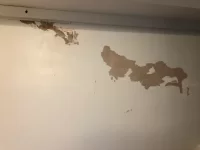

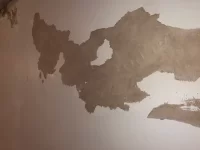
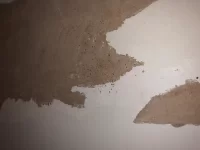
The Bathroom
The blue wall with radiator is in my bathroom. Again the paint is shiny and perhaps not very porous. I've removed the loose paint with a scraper. You can see there are still bits of paint that are slightly darker/damp. Not sure exactly what all the layers of this wall are. It looks to be constructed of black breeze block stuff, as in the black circle to at the right of the image is a pretty deep gouge into the wall. The light yellow layer in the middle of the patches is a few mm thick and looks to be some sort of substrate rather than paint, then on top of that is a thin brown shiny layer, and then a thinner darker yellow layer of maybe old paint. That might all be useless info, but maybe someone recognises the materials as typical of this sort of property. On top of all this is what I assume is white plaster that looks to have been added in the places where the various layers have come away from the wall, to provide a smooth surface. Perhaps this plaster is hydroscopic as the paint has come away in these places. I've scraped away some of the more well adhered paint and there's no white plaster.
Again, any thoughts would be appreciated on how to stabilise the wall and what materials I can use to smooth the wall before painting
